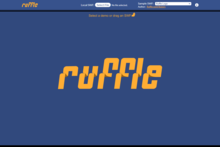
Adobe Flash is a discontinued multimedia software platform used for production of animations, rich internet applications, desktop applications, mobile apps, mobile games, and embedded web browser video players.

Neopets is a free-to-play virtual pet website. First launched in 1999, the website allows users to own virtual pets ("Neopets") and explore a virtual world called "Neopia." Players can earn one of two virtual currencies. One currency, called Neopoints, can be obtained for free through on-site features like games, events, and contests. The other, Neocash (NC), is purchased with real-world money and can be exchanged for wearable items for pets.

Homestar Runner is an American comedy animated web series and website created by Mike and Matt Chapman, known collectively as The Brothers Chaps. The series centers on the adventures of a large and diverse cast of characters, headed by the titular character, Homestar Runner. It uses a blend of surreal humor, self-parody, satire, and references to popular culture, in particular video games, classic television, and popular music.

A browser game is a video game that is played via the internet using a web browser. They are mostly free-to-play and can be single-player or multiplayer. Alternative names for the browser game genre reference their software platform used, with common examples being Flash games, and HTML5 games.
Newgrounds is a company and entertainment website founded by Tom Fulp in 1995. It hosts user-generated content such as games, films, audio, and artwork. Fulp produces in-house content at the headquarters and offices in Glenside, Pennsylvania.
SWF is a defunct Adobe Flash file format that was used for multimedia, vector graphics and ActionScript.

A stick figure, or stick man, is a very simple drawing of a person composed of a few lines and a circle. Often drawn by children, stick figures are known for their simplistic style. The head is most often represented by a circle, which can be a solid color or embellished with details such as eyes, a mouth, or hair. The arms, legs, torso, and abdomen are usually represented with straight lines. Details such as hands, feet, and a neck may be present or absent; simpler stick figures often display an ambiguous emotional expression or disproportionate limbs.

Alien Hominid is a run and gun video game developed by The Behemoth and first released as a Flash game on the multimedia website Newgrounds on August 7, 2002. It was originally developed in Adobe Flash by programmer and Newgrounds founder, Tom Fulp, and animator and artist, Dan Paladin. It has since been re-released in several expanded and enhanced iterations for home consoles and computers.
A Rich Internet Application is a web application that has many of the characteristics of desktop application software. The concept is closely related to a single-page application, and may allow the user interactive features such as drag and drop, background menu, WYSIWYG editing, etc. The concept was first introduced in 2002 by Macromedia to describe Macromedia Flash MX product. Throughout the 2000-s, the term was generalized to describe browser-based applications developed with other competing browser plugin technologies including Java applets, Microsoft Silverlight.
Adobe Flash Player is computer software for viewing multimedia content, executing rich Internet applications, and streaming audio and video content created on the Adobe Flash platform. It can run from a web browser as a browser plug-in or independently on supported devices. Originally created by FutureWave under the name FutureSplash Player, it was renamed to Macromedia Flash Player after Macromedia acquired FutureWave in 1996. It was then developed and distributed by Adobe as Flash Player after Adobe acquired Macromedia in 2005. It is currently developed and distributed by Zhongcheng for users in China, and by Harman International for enterprise users outside of China, in collaboration with Adobe.

Gnash is a media player for playing SWF files. Gnash is available both as a standalone player for desktop computers and embedded devices, as well as a plugin for the browsers still supporting NPAPI. It is part of the GNU Project and is a free and open-source alternative to Adobe Flash Player. It was developed from the gameswf project.

Thomas Charles Fulp is an American programmer known for creating the website Newgrounds and co-founding the video game company The Behemoth.
Google Native Client (NaCl) is a discontinued sandboxing technology for running either a subset of Intel x86, ARM, or MIPS native code, or a portable executable, in a sandbox. It allows safely running native code from a web browser, independent of the user operating system, allowing web apps to run at near-native speeds, which aligns with Google's plans for ChromeOS. It may also be used for securing browser plugins, and parts of other applications or full applications such as ZeroVM.

Armor Games is an American video game publisher and free web gaming portal. The website hosts over a thousand HTML5 browser games. Based in Irvine, California, the site was founded in 2004 by Daniel McNeely.
Modern HTML5 has feature-parity with the now-obsolete Adobe Flash. Both include features for playing audio and video within web pages. Flash was specifically built to integrate vector graphics and light games in a web page, features that HTML5 also supports.

Zombo.com is a single-serving site created in 1999. It was originally a faculty and student joke from the George Washington University Center for Professional Development. The site parodies Flash introductory web pages that play while the rest of a site's content loads. Zombo took the concept to a humorous extreme, consisting of one long introductory page that leads to an invitation to sign up for a newsletter.

The Chromium Embedded Framework (CEF) is an open-source software framework for embedding a Chromium web browser within another application. This enables developers to add web browsing functionality to their application, as well as the ability to use HTML, CSS, and JavaScript to create the application's user interface.
Stage3D is an Adobe Flash Player API for rendering interactive 3D graphics with GPU-acceleration, within Flash games and applications. Flash Player or AIR applications written in ActionScript 3 may use Stage3D to render 3D graphics, and such applications run natively on Windows, Mac OS X, Linux, Apple iOS and Google Android. Stage3D is similar in purpose and design to WebGL.

The KDE Gear is a set of applications and supporting libraries that are developed by the KDE community, primarily used on Linux-based operating systems but mostly multiplatform, and released on a common release schedule.

Pico's School is a 1999 Flash game developed by Tom Fulp for his website Newgrounds. At the time of its release, it was "one of the most sophisticated" browser games, exhibiting "a complexity of design and polish in presentation that [was] virtually unseen in amateur Flash game development". It has been widely credited with kickstarting the Flash games scene and helping launch Newgrounds "as a public force".












